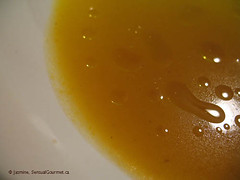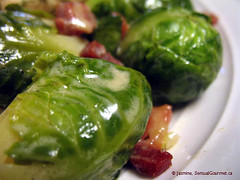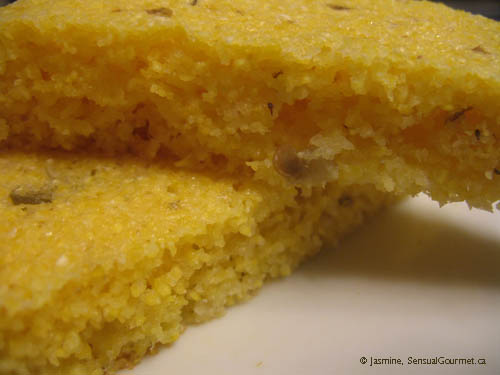Vegetable Harvest
By Patricia Wells
William Morrow/Harper Collin (2007)
324 pp.; C$43.95
Disclosure: Book provided by the publisher.
There are two sorts of vegetables in my life—those I devour and those I wish I hadn’t.
More often than not the latter category contains an odd either/or scenario. Either the cook prinked and fripped and away the vegetable’s inherent characteristics (taste mostly, but also texture and colour), or they ignored the veg’s innate wondrousness and boiled them to within an inch of their lives, leaving a sulky mess in the pot, so unappetising that I wish I had some pigs to feed (I know, unfair to the pigs). All veggies need is a bit of common sense. No, I don’t fall into the “all you need to do is steam them” camp—although that can be extremely satisfying—what I mean is all they need is to be treated with a bit of courtesy and in ways that best bring out their flavours. Anyone who needs help with this need only turn to Patricia Wells’ latest tome, Vegetable Harvest.
Well known in food circles, Wells is the restaurant critic for the French weekly, L’Express, and is the food critic for The International Herald Tribune, a post she’s held for more than 25 years. Vegetable Harvest is her tenth book and follows her passion for French cooking. She lives in Paris and runs a cooking school from her hilltop farmhouse in Provence.
Wells divides Vegetable Harvest into 12 sections, covering everything from starters to desserts and the pantry. The recipes are well-written, easy to follow and entices her American audience to delve into the realm of French cookery. For those of us whose first taste of French food was at a pretentious restaurant that swathed everything in heavy sauces, or were equally heavy handed with thyme or lavender, her recipes enforce the concepts of every regional cuisine I know of: fresh produce easily prepared to showcase their best attributes. Her “Roasted Asparagus with Arugula and Shallot Vinaigrette” features green asparagus, drizzled with shallot vinaigrette and sprinkled with sea salt before roasting, served on rocket leaves tumbled with chive snips, finished with Parmigiano-Reggiano cheese and fleur de sel. These recipes utilise well-stocked pantries and well-tended gardens, failing those, an adequately shelved grocers will do.
I particularly enjoyed reading the post-scripts attached to some recipes. She gives tips based on her own learnings (wash the lid and top edge of corn syrup bottles prior to closing them up, otherwise “you’ll need a sumo wrestler to help you open it!”); wine suggestions; quotations (one of my favourites from Marcel Boulestin is “It is not really an exaggeration to say that happiness begin, geographically where garlic is used in cooking.”); historical notes, customs and folklore (the number of papery leaves on an onion will predict a winter’s severity), and seasonal menus.
The only odd bit I found in the book were the sections devoted to animal protein. Since it was entitled “Vegetable Harvest” I assumed the recipes would be, well, all about things that grow on trees or plants. It would also be nice to have weight equivalents for dry goods as opposed to volume metrics. There are a couple of faults I found: because of the inclusion of meat and meat products in some recipes, it would be helpful to have a list of vegan recipes for quick-reference. The other fault lies in either the photography or the printing—the photographs, many of which are breathtaking, have more than a few blurred images. Sloppy plates or shaky hands, I don’t know, but they are distracting, somewhat annoying and slightly cheapens an otherwise lovely book.
However, most importantly, the recipes generally produce tasty food. Here are the four I tried:
 Roasted Orange Pepper Soup (Crème de Poivrons Oranges)
Roasted Orange Pepper Soup (Crème de Poivrons Oranges)
If you’ve never roasted peppers before, she provides clear instructions regardless of how you do it (on a flame or in the oven). The flavour is rich with a nice slightly smokiness from the roasting.
By Patricia Wells
William Morrow/Harper Collin (2007)
324 pp.; C$43.95
Disclosure: Book provided by the publisher.
There are two sorts of vegetables in my life—those I devour and those I wish I hadn’t.
More often than not the latter category contains an odd either/or scenario. Either the cook prinked and fripped and away the vegetable’s inherent characteristics (taste mostly, but also texture and colour), or they ignored the veg’s innate wondrousness and boiled them to within an inch of their lives, leaving a sulky mess in the pot, so unappetising that I wish I had some pigs to feed (I know, unfair to the pigs). All veggies need is a bit of common sense. No, I don’t fall into the “all you need to do is steam them” camp—although that can be extremely satisfying—what I mean is all they need is to be treated with a bit of courtesy and in ways that best bring out their flavours. Anyone who needs help with this need only turn to Patricia Wells’ latest tome, Vegetable Harvest.
Well known in food circles, Wells is the restaurant critic for the French weekly, L’Express, and is the food critic for The International Herald Tribune, a post she’s held for more than 25 years. Vegetable Harvest is her tenth book and follows her passion for French cooking. She lives in Paris and runs a cooking school from her hilltop farmhouse in Provence.
Wells divides Vegetable Harvest into 12 sections, covering everything from starters to desserts and the pantry. The recipes are well-written, easy to follow and entices her American audience to delve into the realm of French cookery. For those of us whose first taste of French food was at a pretentious restaurant that swathed everything in heavy sauces, or were equally heavy handed with thyme or lavender, her recipes enforce the concepts of every regional cuisine I know of: fresh produce easily prepared to showcase their best attributes. Her “Roasted Asparagus with Arugula and Shallot Vinaigrette” features green asparagus, drizzled with shallot vinaigrette and sprinkled with sea salt before roasting, served on rocket leaves tumbled with chive snips, finished with Parmigiano-Reggiano cheese and fleur de sel. These recipes utilise well-stocked pantries and well-tended gardens, failing those, an adequately shelved grocers will do.
I particularly enjoyed reading the post-scripts attached to some recipes. She gives tips based on her own learnings (wash the lid and top edge of corn syrup bottles prior to closing them up, otherwise “you’ll need a sumo wrestler to help you open it!”); wine suggestions; quotations (one of my favourites from Marcel Boulestin is “It is not really an exaggeration to say that happiness begin, geographically where garlic is used in cooking.”); historical notes, customs and folklore (the number of papery leaves on an onion will predict a winter’s severity), and seasonal menus.
The only odd bit I found in the book were the sections devoted to animal protein. Since it was entitled “Vegetable Harvest” I assumed the recipes would be, well, all about things that grow on trees or plants. It would also be nice to have weight equivalents for dry goods as opposed to volume metrics. There are a couple of faults I found: because of the inclusion of meat and meat products in some recipes, it would be helpful to have a list of vegan recipes for quick-reference. The other fault lies in either the photography or the printing—the photographs, many of which are breathtaking, have more than a few blurred images. Sloppy plates or shaky hands, I don’t know, but they are distracting, somewhat annoying and slightly cheapens an otherwise lovely book.
However, most importantly, the recipes generally produce tasty food. Here are the four I tried:
 Roasted Orange Pepper Soup (Crème de Poivrons Oranges)
Roasted Orange Pepper Soup (Crème de Poivrons Oranges)If you’ve never roasted peppers before, she provides clear instructions regardless of how you do it (on a flame or in the oven). The flavour is rich with a nice slightly smokiness from the roasting.
 Chicken Breasts with Mint, Capers, and White Wine (Blancs de Poulet à la Menthe)
Chicken Breasts with Mint, Capers, and White Wine (Blancs de Poulet à la Menthe)I must admit to trepidations about using mint and chicken, but it the combination of mint, capers and wine works well and probably would be just as tasty with pork, and perhaps shrimp. Very fast and very easy, this makes a good mid-week dish.
 Steamed Brussels Sprouts with Bacon and Cream (Choux de Bruxelles à la Crème au Bacon)
Steamed Brussels Sprouts with Bacon and Cream (Choux de Bruxelles à la Crème au Bacon)I love Brussels sprouts and will admit to a bit of curiosity in this recipe as I generally don’t use cream with my veg, except for soups and potatoes. The bacon’s saltiness cut through the cream to create a very nice dish.
 Jalapeño-Polenta Bread (Pain à la Polenta Epicée)
Jalapeño-Polenta Bread (Pain à la Polenta Epicée)Of all the recipes I tried, this was my least favourite. I just didn’t think the flavour was there and I thought the call for a 10” pan was a bit big for this. I probably won’t make this again.
This book will give you lots of enticing ideas for veggies and meats. The recipes are clearly written and easy to follow.
At a Glance:
Overall: 4/5
The Breakdown:
Writing/Translation: 4/5
Recipe Selection: 4.5
Ease of use: 4/5
Yumminess: 4/5
Kitchen comfort-level: basic-intermediate
Pro: Contains easy and tasty recipes.
Con: It’s not a vegetarian cookbook; vegan recipes aren’t identifiable in the index.
cheers!
jasmine
tags:
add this page to del.icio.us


6 comments:
Jasmine I have this book too. I've barely opened it, but the brussels sprouts recipe looks interesting.
These dishes sound wonderful!
I just bought this book, too, but I haven't yet begun to cook from it. Your review is really helpful -- thanks.
I ALMOST bought this book for a mother's day gift, but chose "Keep It Simple" by Annie Wayte instead....they seemed similar to me but the second has absolutely gorgeous photography (who says a cookbook can't also be a coffee table book?)
Jasmine, dearest - I have thought about purchasing this book because I have one of the author's others, but your review has cautiously advised me to be discerning in doing so. I will be sure to weigh your pros and cons with the recipe selections. Your review seems very balanced and open, informative enough to guide anyone through a cursory glance at Wells' latest cookery book. I, too, am intrigued by the chicken with mint dish.
Hello all
It is a good book and I'm sure people will get a lot of use out of it. As I said, the most surprising thing about it was the inclusion of meat as main ingredients--the meat dish I tried was absolutely lovely, though.
j
Post a Comment